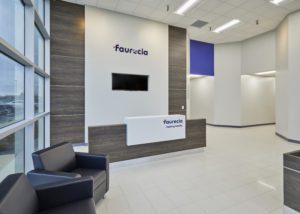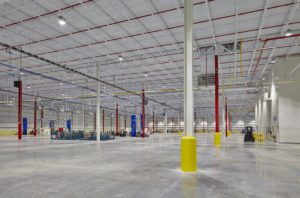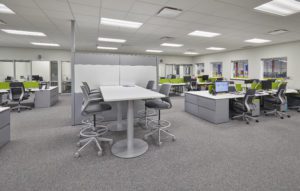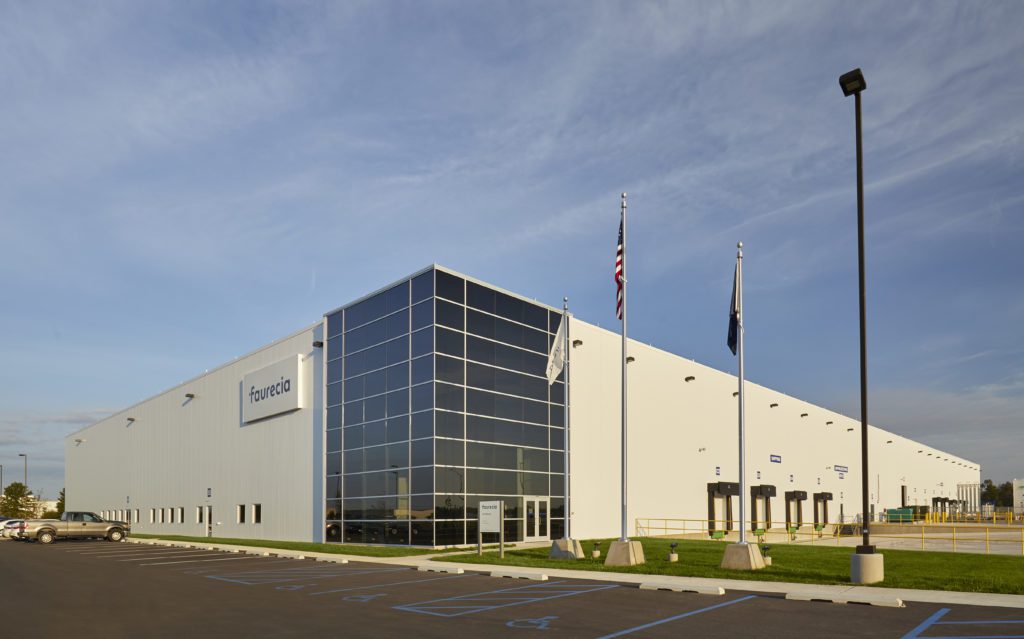Faurecia Clean Mobility, a global manufacturer of automotive emissions control systems with North American headquarters based in Columbus, Ind., opened a new production facility in Fort Wayne in August 2017, introducing more than 140 jobs to the community. The project’s story is a prime example of a team working together to meet a common goal.
A different kind of starting line
Like many communities, Fort Wayne has placed a high priority on job creation and economic development, with a focus on manufacturing and distribution companies. As the pace of work has increased, so has the need to bring these facilities online quickly.
“In the past, the focus in Fort Wayne and Allen County has been on having shovel-ready real estate for manufacturing and distribution companies building new facilities,” said Nancy Townsend, redevelopment director, City of Fort Wayne. “Over the past few years, we’ve found shovel-ready isn’t enough. We need to be further along for businesses making the decision to relocate or expand.”
Nancy pointed out that having shell or speculative buildings underway reduces the burden of the businesses to hire the design and construction team, bring utilities to the site and go through land use and permitting processes. So far, the City of Fort Wayne Redevelopment Commission has partnered on three speculative buildings that are all fully occupied and have either created or retained hundreds of jobs.
Accelerating growth
An area in which the City has made a priority for development is within one of the City’s existing TIF (tax increment financing) areas established to attract and retain jobs. Located near Fort Wayne International Airport, the site provides easy access to both air and interstate travel. “It’s in an area that’s robust with water, sewer and other utilities, so putting all those factors into the equation provides growth opportunities for manufacturing, distribution and other job creators,” Nancy said.
The Fort Wayne Redevelopment Commission partnered with The Hagerman Group, HBC Realty Corporation and Greater Fort Wayne Inc. to create a speculative building—delivered through the design-build project delivery method—that would attract businesses to the site and fuel job creation. “We appreciated the partnership with Hagerman and how they worked to meet our needs,” said Nancy.
 The Hagerman Group, along with architect- and engineer-of-record Vintage Archonics, had started foundation work for a 100,000-square-foot shell building, when—right around the holidays—they received a gift: news that Faurecia Clean Mobility was interested in the site.
The Hagerman Group, along with architect- and engineer-of-record Vintage Archonics, had started foundation work for a 100,000-square-foot shell building, when—right around the holidays—they received a gift: news that Faurecia Clean Mobility was interested in the site.
According to John Jaffe, industrial project manager, Faurecia, Fort Wayne was appealing because of the central location and access to key customers and suppliers of Faurecia in the Midwest.
“Expected economic growth and a strong labor pool also contributed to our decision to open operations in Fort Wayne,” he said. “Hagerman’s Fort Wayne project met several key measures Faurecia sought for our new manufacturing facility.”
Faurecia was seeking a location and facility that provided for both immediate needs and for future growth and scope evolution for their customers.
“Originally, we were seeking an existing facility to meet our needs in Fort Wayne,” John said.
“We anticipated improvements and renovations would be needed in the facilities we considered. Building a new facility would have posed a timing risk. The Hagerman project had already started when the option was presented to us. This provided an opportunity for us to modify some design elements to incorporate some of our corporate standards and add the flexibility we were seeking. Hagerman was up front when presented with our timing and preferences. Brad Smith said the schedule would be tight, but they could meet the timeline, and they did.”
While move-in ready buildings can help spur economic development on a faster timeline, in this case, the early stage of the project was beneficial because of the amount of square feet and customization Faurecia needed to support its unique equipment, standards and operations.
“They liked the location and the starting point but needed to increase the building size by about 50 percent, on a faster track,” said Brad Smith, executive vice president, Hagerman.
The schedule included two months for design and five months for construction.
 Lucas Konger, RA, AIA, ACHA, president, Vintage Archonics, said the biggest challenge was modifying existing foundations and re-evaluating the structural design to add on three 50-foot bays and accommodate additional loading docks. “That was a big undertaking for us, and Hagerman had to make changes in the field as well,” said Lucas.
Lucas Konger, RA, AIA, ACHA, president, Vintage Archonics, said the biggest challenge was modifying existing foundations and re-evaluating the structural design to add on three 50-foot bays and accommodate additional loading docks. “That was a big undertaking for us, and Hagerman had to make changes in the field as well,” said Lucas.
The 140,415-square-foot facility is made up of approximately 13,500 square feet of offices and 127,000 square feet for manufacturing and service. The entry and office areas include unique features and layouts consistent with Faurecia’s brand while accommodating technology and employees’ ways of working. Special considerations in the manufacturing areas maximize safety and usable square footage.The facility is built to expand in the future, if needed, with insulated metal panels as exterior walls.
On the fast track: Keys to success
Adding complexity to the expanded scope and design changes on an accelerated project schedule was the fact construction activities for Faurecia’s future home would be occurring during the winter in northeast Indiana. The design and construction team reacted to the challenges along the way, meeting deadlines and requirements and exceeding expectations. Several factors were key to its successful completion.
Have a Plan B and C.
“We took the time to make plans based on the potential severity of the winter of 2016-17, as well as planning out solutions should certain obstacles arise,” said Brad.
Be flexible.
“The team needed to be able to make suggestions and offer ideas on the fly,” said Rob Young, vice president of business development, Hagerman. “Flexibility in the face of intense deadlines was a theme from everyone involved.”
Communicate, coordinate and commit.
“Communication had to happen seamlessly between design and construction,” Rob said. “We spent lot of time in each other’s offices coordinating to incorporate the client’s feedback without incurring additional costs.”
“It was really a coordinated effort to where our team, the Hagerman team and the subcontractors sat in a room and hashed out the design components so that everyone was 100 percent aware of what was going to have to take place,” said Lucas. “The team coordinated the effort to get from point A to point B in a short timeframe.”
From the design-build team members to the client, all team members made the project a priority. “Faurecia showed an incredible commitment to this project as well, efficiently collaborating on their end to gain the approvals needed on a global level,” said Brad. “Lots of people had to come together, quickly and consistently.”
“Communication, collaboration, and efficient decision making were the biggest contributors to the success of the project,” John said. “We had weekly meetings, on site, with Hagerman and their subcontractors. This is not typical. Often times, general contractors and/or developers do not necessarily want their customers to sit in on their contractor coordination meetings. Everything was very transparent. I recall that during construction we learned that special provisions for dock doors had to be made for a specific type of trailer that would be needed to ship our product. The team on site was able to discuss it at one meeting, make a few phone calls and plan changes. A week later, we had options, pricing, and a decision was made to proceed to execute the modifications.”
The finish line
The project was a success, both in its timely completion as well as its impact on the community.
 “This was not an easy project on paper or in practice. Hagerman exceeded my expectations,” said John. “Despite a condensed schedule, a redesigned and expanded structure, and a winter start date, Hagerman met every scheduled milestone on the project. More importantly, there were no safety incidents and the project was kept organized and clean throughout the construction effort. Communication was consistent and direct. There were no surprises to speak of.”
“This was not an easy project on paper or in practice. Hagerman exceeded my expectations,” said John. “Despite a condensed schedule, a redesigned and expanded structure, and a winter start date, Hagerman met every scheduled milestone on the project. More importantly, there were no safety incidents and the project was kept organized and clean throughout the construction effort. Communication was consistent and direct. There were no surprises to speak of.”
The resulting facility fuels job creation, economic development and advancement of Indiana’s leadership in automotive manufacturing.
“This project demonstrates the importance of partnering with the private sector for redevelopment,” Nancy said. “The job creation alone has been a big boost to Fort Wayne, and Faurecia is supporting it both directly and indirectly through their support of existing businesses in the area.”
“Faurecia is proud of our facility in Fort Wayne,” said John. “This facility will help us to better serve our customers and our employees immediately and in the future. Hopefully we will need to expand the building soon and continue to build on this success.”
“It was a learning experience for our organization and for Hagerman,” said Lucas. “How we worked together was a testament to the whole team and helped Faurecia bring high wage jobs to Fort Wayne in short order.”
“The Hagerman Group is grateful to have had this opportunity to build a facility for a leader in automotive technology,” said Brad. “Faurecia’s presence in Fort Wayne will have a positive impact on the city and the state of Indiana for years to come.”
Team Members:
John Jaffe, Industrial Project Manager, Faurecia
Brad Smith, Project Executive, The Hagerman Group
Rob Young, Client Liaison, The Hagerman Group
Ben Stuby, Project Manager, The Hagerman Group
Josh Pinney, Project Engineer, The Hagerman Group
Kary Knox, Project Superintendent, The Hagerman Group
Rachel Gumbiner, Project Coordinator, The Hagerman Group
Lucas Konger, Project Executive, Vintage Archonics
Eric Till, Project Architect, Vintage Archonics
Kyle Kater, Mechanical Engineer, Vintage Archonics
Scott Seiler, Electrical Engineer, Vintage Archonics
Mark Reinhard, Civil Engineer, Engineering Resources
Dan Schenkel, Structural Engineer, Engineering Resources

